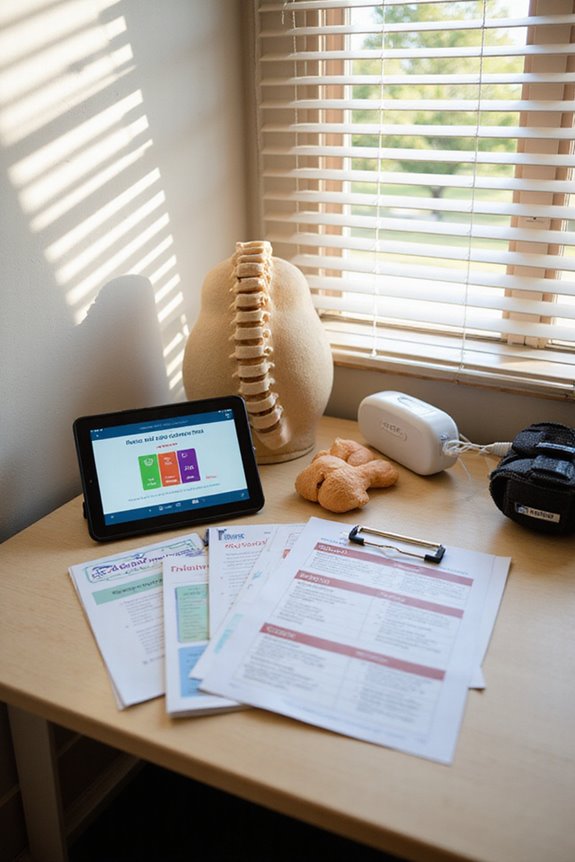Pain education resources enhance self-advocacy in several key ways:
- Access to Accurate Knowledge: They provide essential information about chronic pain types and effective management techniques.
- Management Skills Improvement: Resources teach practical skills that help reduce pain intensity and improve functionality.
- Enhanced Communication: Patients learn to articulate symptoms clearly, fostering informed discussions with healthcare providers.
- Psychological Support: Educational programs promote psychological resilience, empowering patients to engage in their care.
Understanding these aspects can lead to better health outcomes and informed decision-making.
Key Takeaways
- Pain education resources empower individuals to understand their condition, enhancing their ability to advocate for appropriate treatment options with healthcare providers.
- By improving symptom clarity, education helps patients articulate their pain experiences, fostering more effective communication and shared decision-making with clinicians.
- Access to practical pain management techniques boosts patient confidence, enabling them to actively engage in their own care and self-management plans.
- Psychological education enhances emotional resilience, equipping individuals to navigate challenges and advocate for their needs in chronic pain management.
- Awareness of support networks and multidisciplinary teams encourages patients to seek coordinated care, reinforcing their role as active participants in their health journey.
Access to Accurate Pain Knowledge
How can individuals effectively navigate the complexities of chronic pain? Access to accurate pain knowledge is essential for fostering pain literacy, which empowers individuals to understand their conditions. Remarkably, 20.9% of U.S. adults experienced chronic pain from 2019 to 2021, with 6.9% facing high-impact chronic pain that greatly limits daily activities.
Key points include:
- Knowledge gaps persist between effective pain management and clinical practice.
- Consistent definitions of chronic pain are vital for self-assessment and communication with providers.
- Accurate pain education helps individuals differentiate pain types and seek appropriate interventions.
Enhancing access to reliable information nurtures informed discussions with healthcare providers, ultimately improving health outcomes and advocating for better pain management standards.
Improvement in Pain Management Skills

Improvement in pain management skills considerably enhances the ability of individuals to navigate chronic pain effectively.
- Pain education resources offer practical pain management techniques, such as relaxation and cognitive restructuring.
- Studies indicate that single-session pain management classes can lead to clinically significant skill acquisition in chronic low back pain.
- Enhanced understanding of pain mechanisms allows individuals to reduce pain catastrophizing, fostering better coping strategies.
- Consistent application of learned self-management skills correlates with decreased pain intensity and improved functional status.
- Education also boosts adherence to prescribed management plans by increasing patient confidence.
Enhancement of Communication With Healthcare Providers

Effective communication between patients and healthcare providers plays a crucial role in managing chronic pain. Enhanced patient understanding through pain education facilitates:
- Symptom Clarity: Patients learn to identify and describe various pain types, improving accuracy in reporting.
- Informed Engagement: Education empowers patients to ask relevant questions about treatment options and express concerns.
- Structured Tools: Resources like pain diaries help track symptoms systematically, fostering clearer communication.
- Reduced Anxiety: Understanding pain mechanisms diminishes fear and facilitates productive conversations.
These elements contribute to a strengthened partnership, allowing patients to actively participate in shared decision-making. Ultimately, effective communication enhances treatment satisfaction, ensuring that healthcare providers can tailor interventions to meet individual patient needs.
Promotion of Psychological Well-being

Promotion of Psychological Well-being****
Promotion of psychological well-being in the context of chronic pain management represents a significant aspect of overall treatment effectiveness.
- Psychological well-being serves as a key moderator of treatment outcomes, often outweighing demographic and physical factors.
- Positive psychological functioning, including emotional regulation and environmental mastery, predicts better adaptation in chronic pain self-management.
- A lack of psychological resources can hinder engagement in cognitive behavior change essential for pain education.
- Enhanced emotional resilience through psychological education supports long-term self-advocacy and effective pain management.
- Tailoring pain education for individuals with low baseline psychological well-being optimizes treatment allocation and results.
Improving psychological well-being fosters a more robust quality of life and enhances overall psychological functioning for individuals experiencing chronic pain.
Facilitating Access to Broader Support Networks

Facilitating access to broader support networks is essential for individuals managing chronic pain, as it enhances their ability to navigate the complexities of treatment and self-advocacy.
- Pain education resources improve awareness of specialized pain care professionals, facilitating peer connections and referrals.
- Increased knowledge of multidisciplinary teams supports coordinated care, promoting community engagement.
- Pain champions serve as navigational points within the healthcare system, enhancing access to clinical resources.
- Educational programs encourage collaboration between academic and clinical sectors, expanding available support networks.
- Schools can develop tailored accommodations, creating inclusive environments for students with chronic pain.
- Online health communities provide emotional validation, reducing isolation and enhancing coping strategies through shared experiences.
These frameworks collectively strengthen individuals’ capacity for effective self-advocacy.
Frequently Asked Questions
What Types of Pain Education Resources Are Available Online?
Various online pain education resources are available, including educational videos, interactive courses, and community support platforms. These resources foster a sense of belonging, offering patients valuable knowledge and tools to manage their pain effectively.
How Can I Find Reputable Pain Education Materials?
Finding reliable pain education materials involves evaluating sources based on their endorsement by recognized organizations, evidence-based content, and multidisciplinary expert involvement. Engaging with reputable platforms fosters a sense of community and shared understanding among individuals facing similar challenges.
Are There Any Costs Associated With Accessing Pain Education Resources?
Like a bridge built over troubled waters, accessing pain education resources often comes with cost barriers and access limitations. While some materials are free, others may impose significant financial burdens that hinder effective pain management for many individuals.
How Often Should I Revisit Pain Education Materials?
Revisiting frequency of pain education materials should be weekly during initial phases, with monthly refreshers thereafter. Material updates should align with patient needs, promoting comprehension and sustaining motivation for effective chronic pain management and self-advocacy.
Can Pain Education Resources Help With Specific Conditions Like Fibromyalgia?
In the garden of healing, pain education resources bloom, offering fibromyalgia patients seeds of knowledge. With nurturing insights into pain management techniques, these resources cultivate understanding, empowering individuals to navigate their symptoms and embrace a supportive community.





